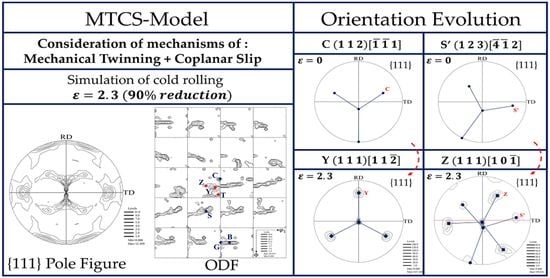Rolling Texture of Cu–30%Zn Alloy Using Taylor Model Based on Twinning and Coplanar Slip
Abstract
:1. Introduction
2. Materials and Methods
3. Modelling
3.1. FC-Model
3.2. RC-Model
3.3. MT-Model
3.4. MTCS-Model
4. Results and Discussion
4.1. Effect of Twinning on the Rolling Texture
4.2. Formation of Y Orientation
4.3. Formation of Z Orientation
5. Conclusions
Author Contributions
Funding
Data Availability Statement
Acknowledgments
Conflicts of Interest
References
- Engler, O.; Randle, V. Introduction. In Introduction to Texture Analysis: Macrotexture, Microtexture, and Orientation Mapping, 2nd ed.; CRC Press: Boca Raton, FL, USA, 2010; pp. 5–7. [Google Scholar]
- Duggan, B.J.; Hatherly, M.; Hutchinson, W.B.; Wakefield, P.T. Deformation structures and textures in cold-rolled 70: 30 brass. Met. Sci. 1978, 12, 343–351. [Google Scholar] [CrossRef]
- Fargette, B.; Whitwham, D. Plastic Deformation of the Brass CuZn 30 by Heavy Rolling Reductions. Mem. Sci. Rev. Metall. 1976, 73, 197–206. [Google Scholar]
- Hirsch, J.; Lücke, K.; Hatherly, M. Overview no. 76: Mechanism of deformation and development of rolling textures in polycrystalline fcc metals—III. The influence of slip inhomogeneities and twinning. Acta Metall. 1988, 36, 2905–2927. [Google Scholar] [CrossRef]
- Hatherly, M.; Malin, A. Shear bands in deformed metals. Scr. Metall. 1984, 18, 449–454. [Google Scholar] [CrossRef]
- Malin, A.; Hatherly, M. Microstructure of cold-rolled copper. Met. Sci. 1979, 13, 463–472. [Google Scholar] [CrossRef]
- Wassermann, G. Der einfluss mechanischer zwillingsbildung auf die entstehung der walztexturen kubisch flachenzentrierter metalle. Z. Metallkunde 1963, 54, 61–65. [Google Scholar]
- Paul, H.; Morawiec, A.; Piątkowski, A.; Bouzy, E.; Fundenberger, J.J. Brass-type shear bands and their influence on texture formation. Metall. Mater. Trans. A 2004, 35, 3775–3786. [Google Scholar] [CrossRef]
- Paul, H.; Driver, J.H.; Maurice, C.; Jasieński, Z. Shear band microtexture formation in twinned face centred cubic single crystals. Mater. Sci. Eng. A 2003, 359, 178–191. [Google Scholar] [CrossRef]
- Sevillano, J.G.; van Houtte, P.; Aernoudt, E. Large strain work hardening and textures. Prog. Mater. Sci. 1980, 25, 69–134. [Google Scholar] [CrossRef]
- Van Houtte, P. A comprehensive mathematical formulation of an extended Taylor–Bishop–Hill model featuring relaxed constraints, the Renouard–Wintenberger theory and a strain rate sensitivity model. Texture Stress Microstruct. 1988, 8, 313–350. [Google Scholar] [CrossRef]
- van Houtte, P. On the equivalence of the relaxed Taylor theory and the Bishop-Hill theory for partially constrained plastic deformation of crystals. Mater. Sci. Eng. 1982, 55, 69–77. [Google Scholar] [CrossRef]
- Leffers, T.; Ray, R. The brass-type texture and its deviation from the copper-type texture. Prog. Mater. Sci. 2009, 54, 351–396. [Google Scholar] [CrossRef]
- Hirsch, J.; Lücke, K. Overview no. 76: Mechanism of deformation and development of rolling textures in polycrystalline fcc metals—II. Simulation and interpretation of experiments on the basis of Taylor-type theories. Acta Metall. 1988, 36, 2883–2904. [Google Scholar] [CrossRef]
- Leffers, T. The brass-type texture–how close are we to understand it. Mater. Sci. Forum 2012, 702, 216–223. [Google Scholar] [CrossRef]
- van Houtte, P. Simulation of the rolling and shear texture of brass by the Taylor theory adapted for mechanical twinning. Acta Metall. 1978, 26, 591–604. [Google Scholar] [CrossRef]
- Chin, G.; Hosford, W.; Mendorf, D. Accommodation of constrained deformation in fcc metals by slip and twinning. Proc. R. Soc. Lond. Ser. A 1969, 309, 433–456. [Google Scholar]
- Kallend, J.S. Quantitative Analysis of Texture Data; Cambridge University Press: Cambridge, UK, 1971. [Google Scholar]
- Leffers, T. The brass-type texture once again. In Proceedings of the 11th International Conference on Textures of Materials, Xian, China, 16–20 September 1996; International Academic Publishers: Beijing, China, 1996; pp. 299–306. [Google Scholar]
- Leffers, T. On the development of the brass-type texture. Textures Microstruct. 1970, 22, 53–58. [Google Scholar] [CrossRef] [Green Version]
- Kalidindi, S.R. Incorporation of deformation twinning in crystal plasticity models. J. Mech. Phys. Solids 1998, 46, 267–290. [Google Scholar] [CrossRef]
- Kalidindi, S.R. Modeling anisotropic strain hardening and deformation textures in low stacking fault energy fcc metals. Int. J. Plast. 2001, 17, 837–860. [Google Scholar] [CrossRef]
- Lebensohn, R.A.; Tomé, C. A self-consistent viscoplastic model: Prediction of rolling textures of anisotropic polycrystals. Mater. Sci. Eng. A 1994, 175, 71–82. [Google Scholar] [CrossRef] [Green Version]
- Lebensohn, R.A.; Tomé, C.; Castaneda, P.P. Self-consistent modelling of the mechanical behaviour of viscoplastic polycrystals incorporating intragranular field fluctuations. Philos. Mag. 2007, 87, 4287–4322. [Google Scholar] [CrossRef]
- Toth, L.S.; Haase, C.; Allen, R.; Lapovok, R.; Molodov, D.A.; Cherkaoui, M.; el Kadiri, H. Modeling the effect of primary and secondary twinning on texture evolution during severe plastic deformation of a twinning-induced plasticity steel. Materials 2018, 11, 863. [Google Scholar] [CrossRef] [Green Version]
- Chalapathi, D.; Sivaprasad, P.; Kanjarla, A.K. Role of deformation twinning and second phase on the texture evolution in a duplex stainless steel during cold rolling: Experimental and modelling study. Mater. Sci. Eng. A 2020, 780, 139–155. [Google Scholar] [CrossRef]
- Leffers, T.; Bilde-Sørensen, J. Intra-and intergranular heterogeneities in the plastic deformation of brass during rolling. Acta Metall. Mater. 1990, 38, 1917–1926. [Google Scholar] [CrossRef]
- Duggan, B.; Hutchinson, W.; Hatherly, M. Recrystallization studies in 70: 30 brass using a high voltage electron microscope. Scr. Metall. 1978, 12, 293–295. [Google Scholar] [CrossRef]
- Hutchinson, W.; Duggan, B.; Hatherly, M. Development of deformation texture and microstructure in cold-rolled Cu–30Zn. Met. Technol. 1979, 6, 398–403. [Google Scholar] [CrossRef]
- Donadille, C.; Valle, R.; Dervin, P.; Penellel, R. Development of texture and microstructure during cold-rolling and annealing of FCC alloys: Example of an austenitic stainless steel. Acta Metall. 1989, 37, 1547–1571. [Google Scholar] [CrossRef]
- Paul, H.; Morawiec, A.; Driver, J.H.; Bouzy, E. On twinning and shear banding in a Cu–8 at.% Al alloy plane strain compressed at 77 K. Int. J. Plast. 2009, 25, 1588–1608. [Google Scholar] [CrossRef]
- van Houtte, P.; Aernoudt, E. Considerations on crystal and strain symmetry in calculation of deformation textures with taylor theory. Mater. Sci. Eng. 1976, 23, 11–22. [Google Scholar] [CrossRef]
- Taylor, G.I. Plastic strain in metals. J. Inst. Metals 1938, 62, 307–324. [Google Scholar]
- Hirsch, J.; Lucke, K. Mechanism of Deformation and Development of Rolling Textures in Polycrystalline, F.C.C. Metals. I. Description of Rolling Texture Development in Homogeneous CuZn Alloys. Acta Metall. 1988, 36, 2863–2882. [Google Scholar] [CrossRef]
- Madhavan, R.; Ray, R.K.; Suwas, S. Texture transition in cold-rolled nickel–40 wt.% cobalt alloy. Acta Mater. 2014, 74, 151–164. [Google Scholar] [CrossRef]
- Asbeck, H.; Mecking, H. Influence of friction and geometry of deformation on texture inhomogeneities during rolling of Cu single crystals as an example. Mater. Sci. Eng. 1978, 34, 111–119. [Google Scholar] [CrossRef]
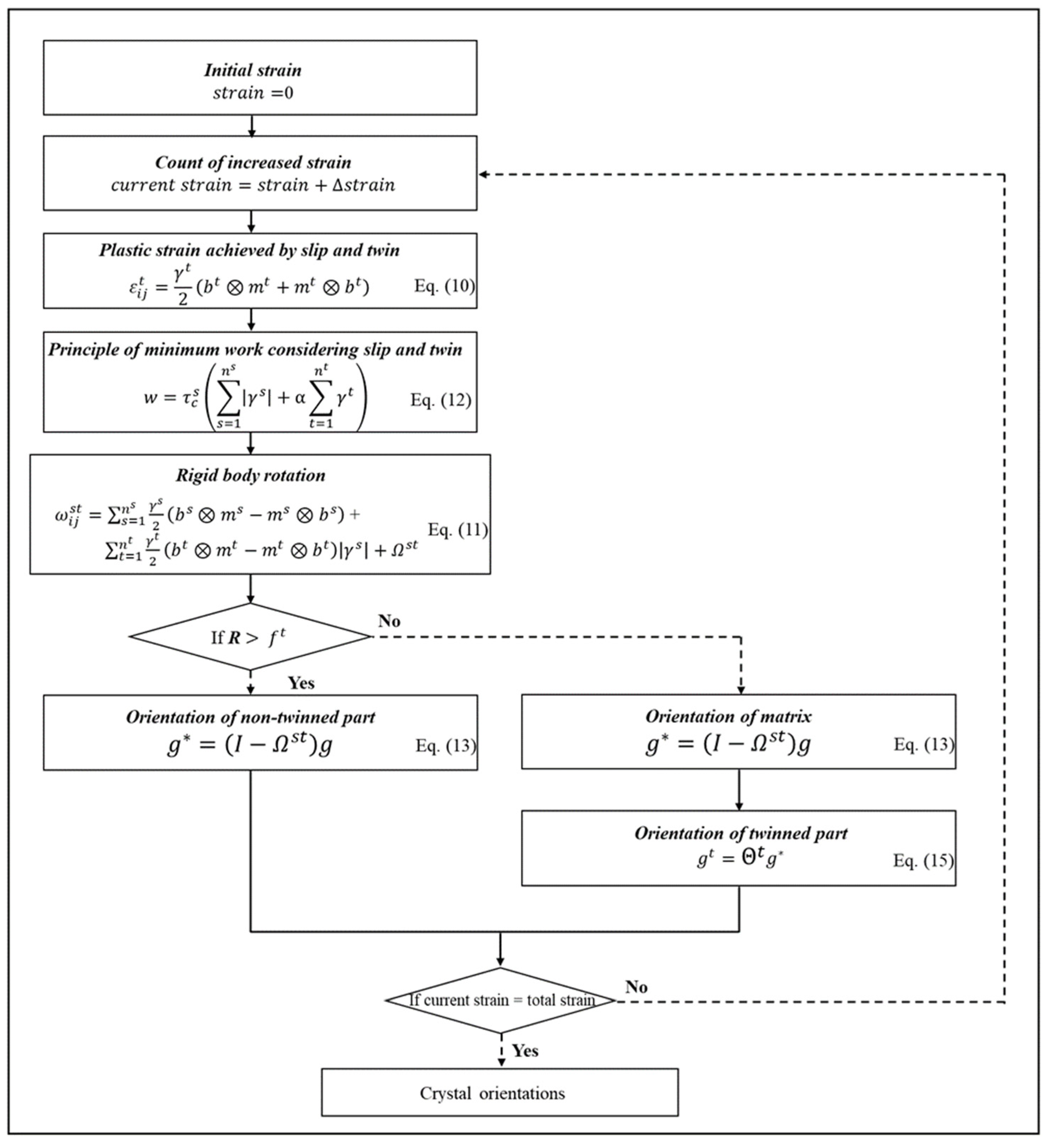
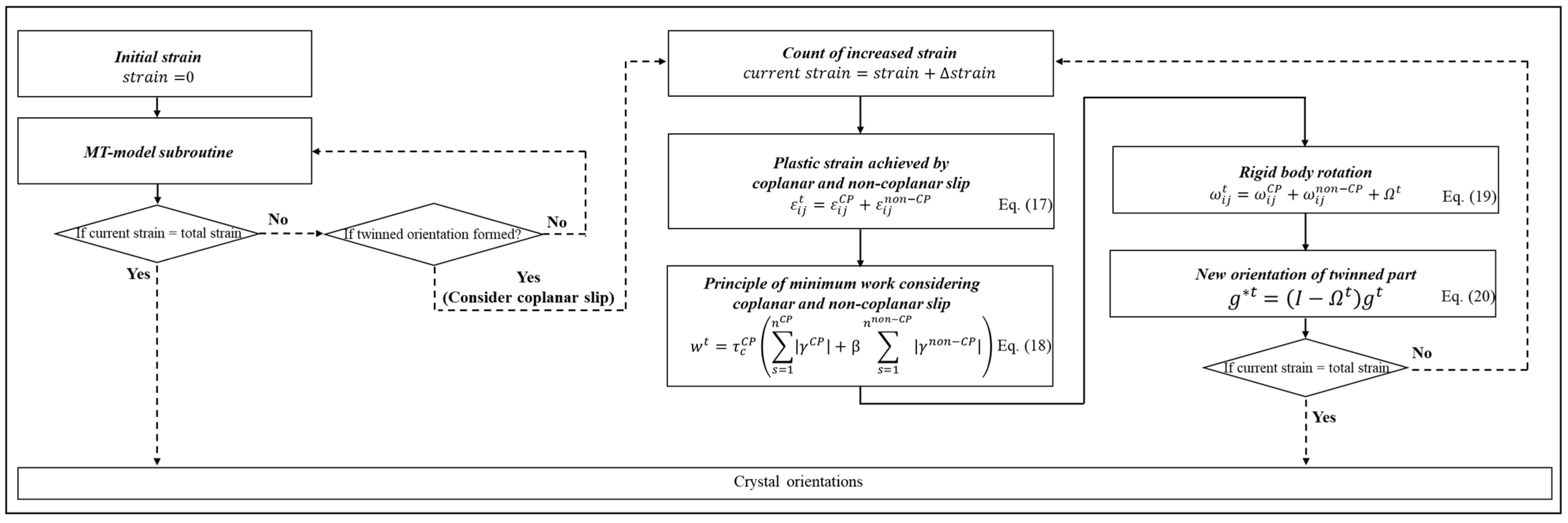
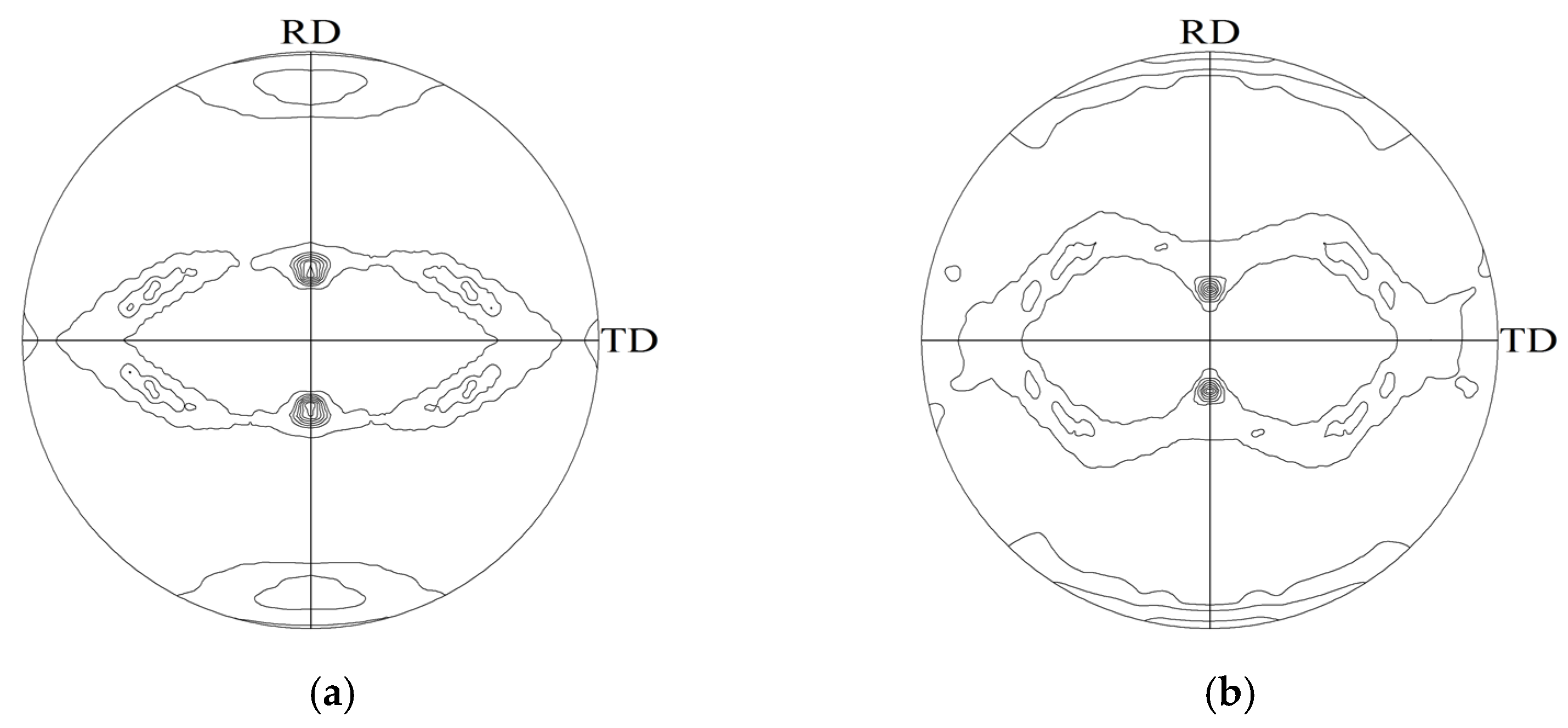
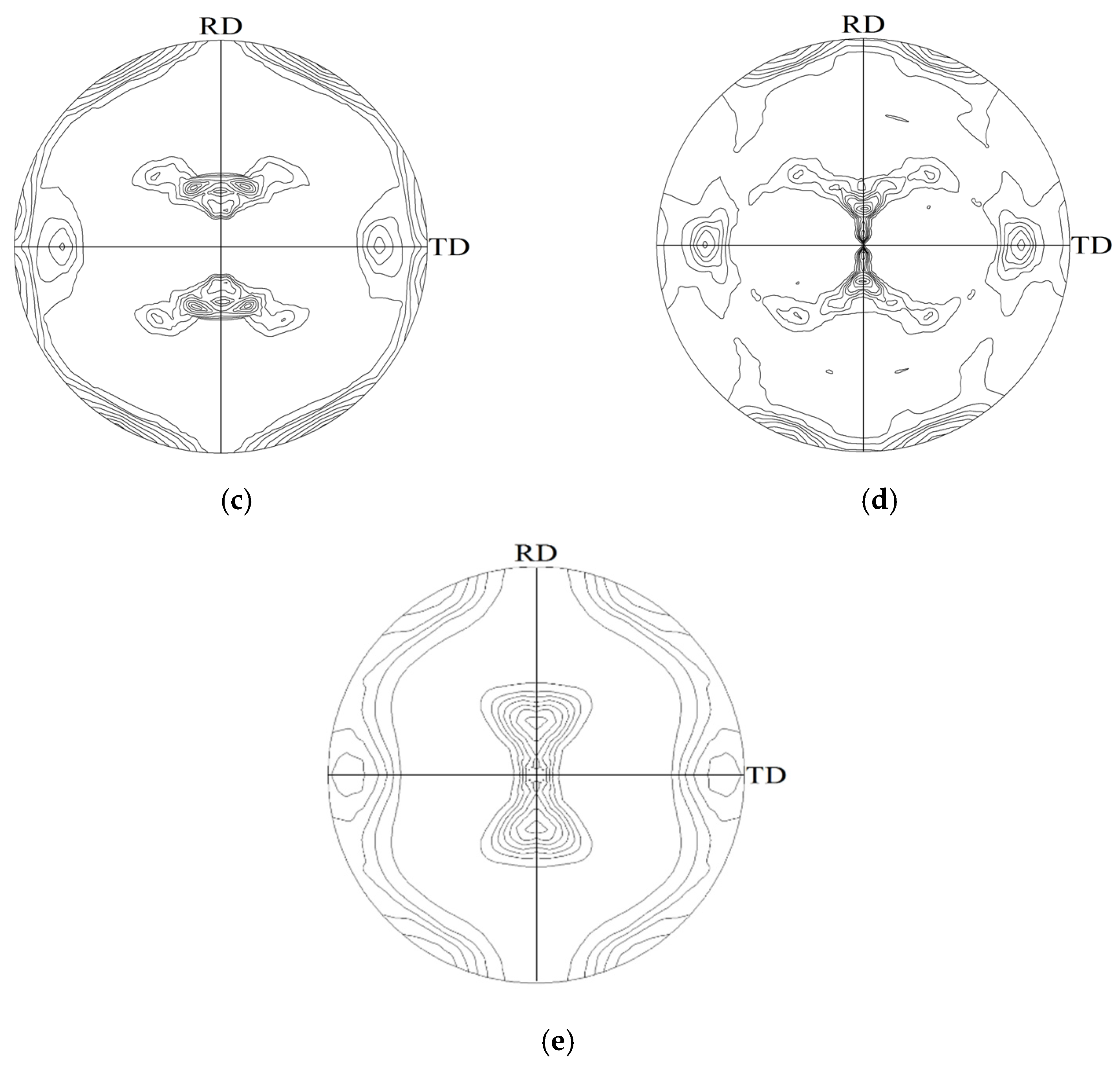
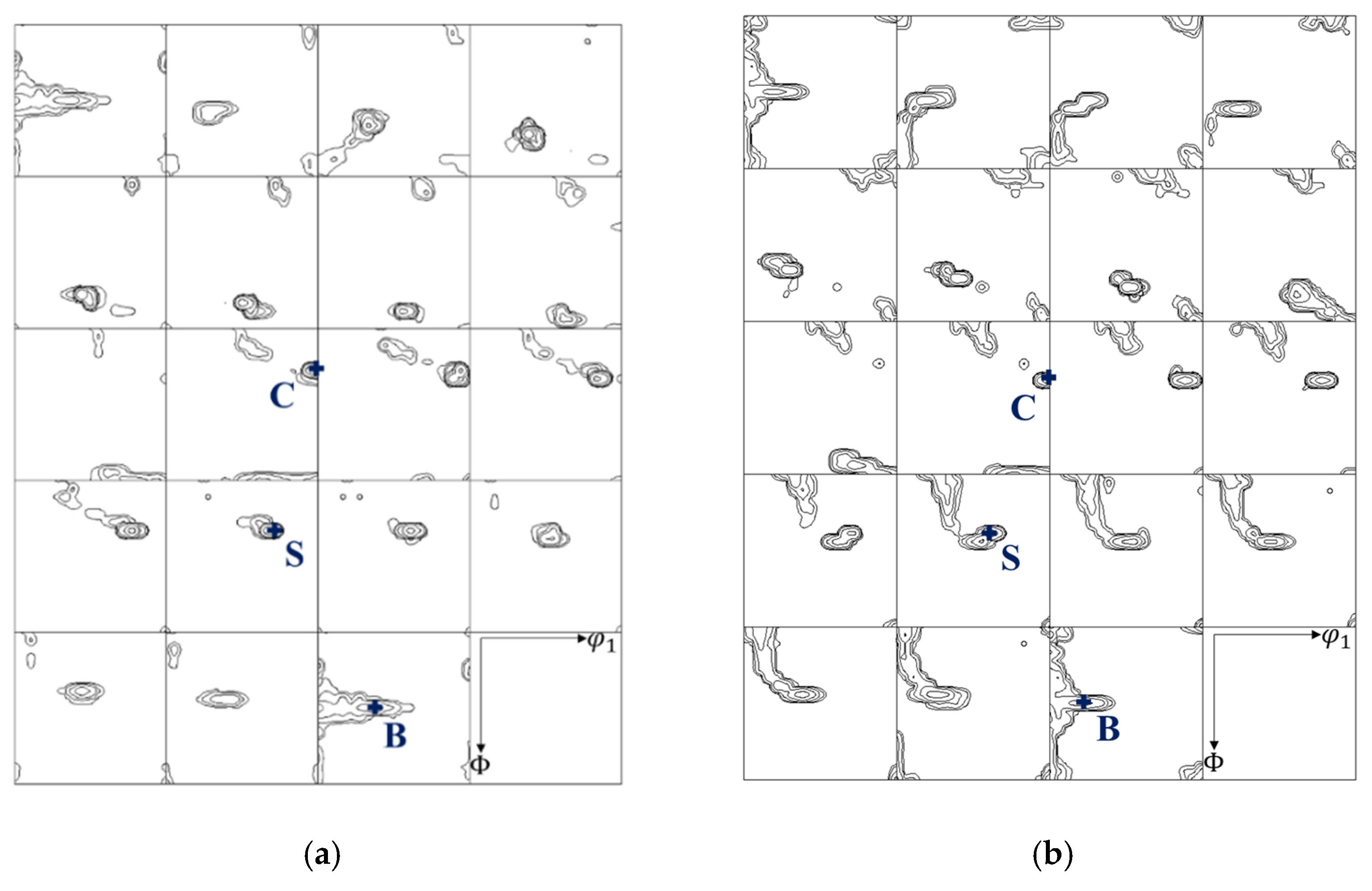
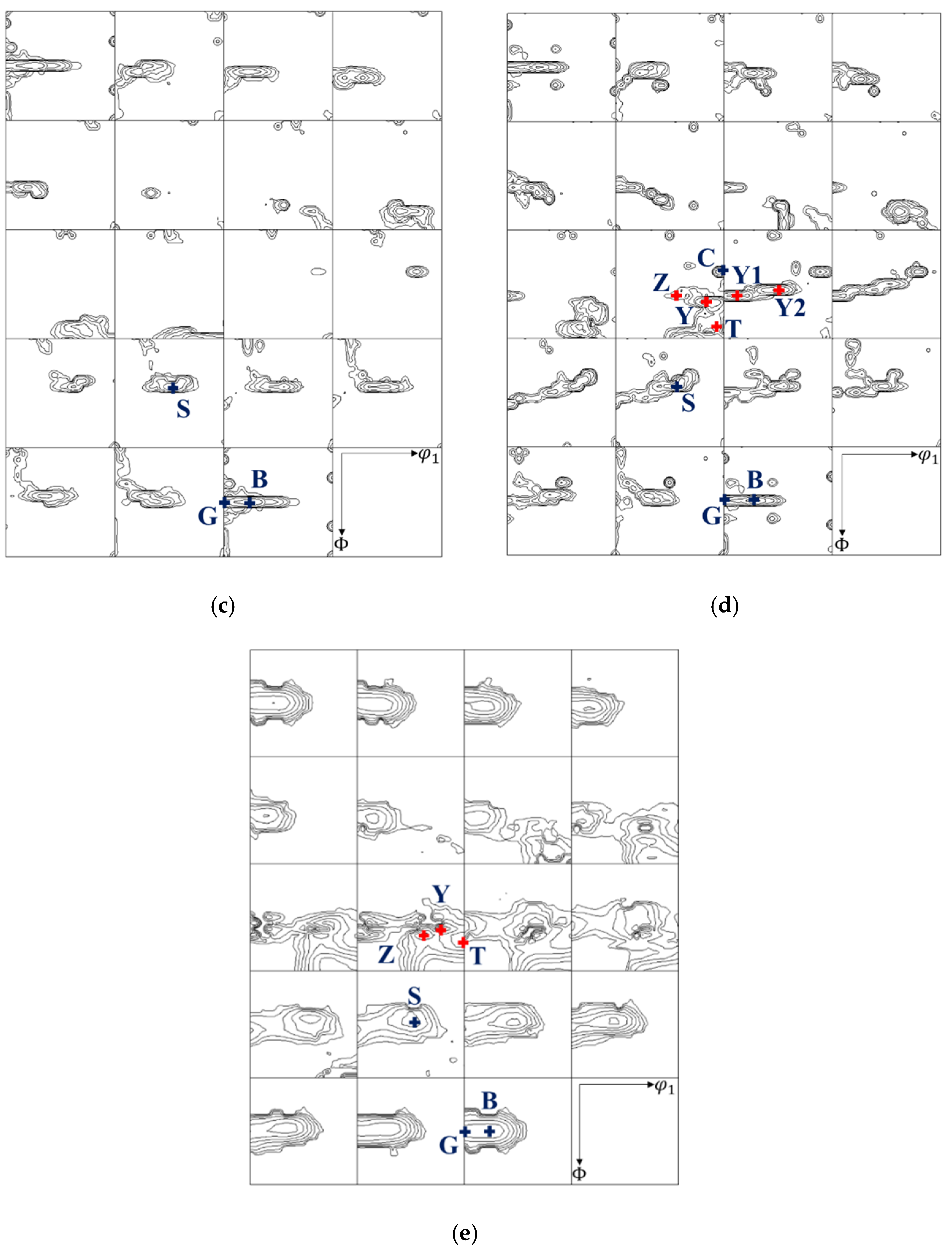
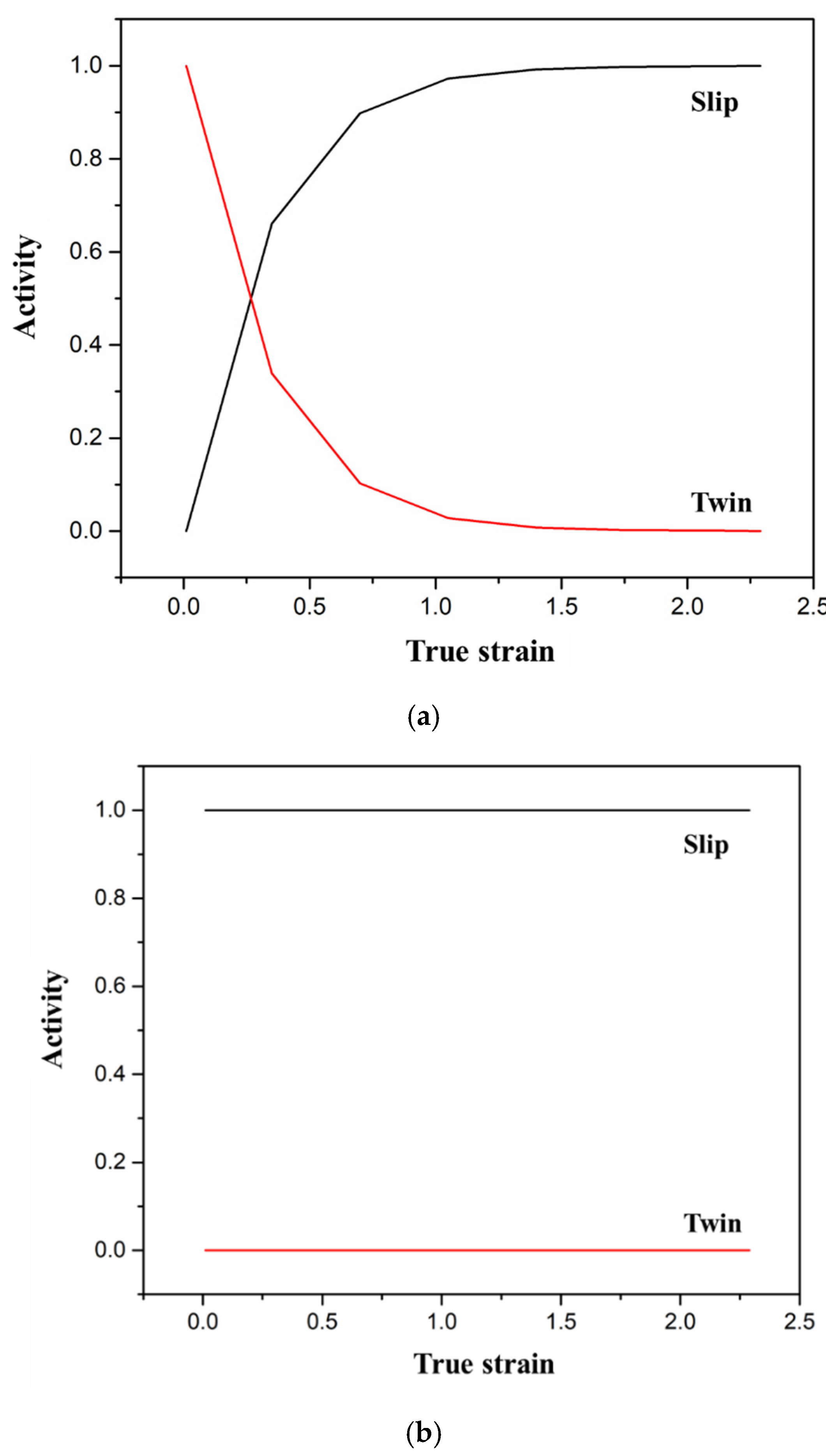
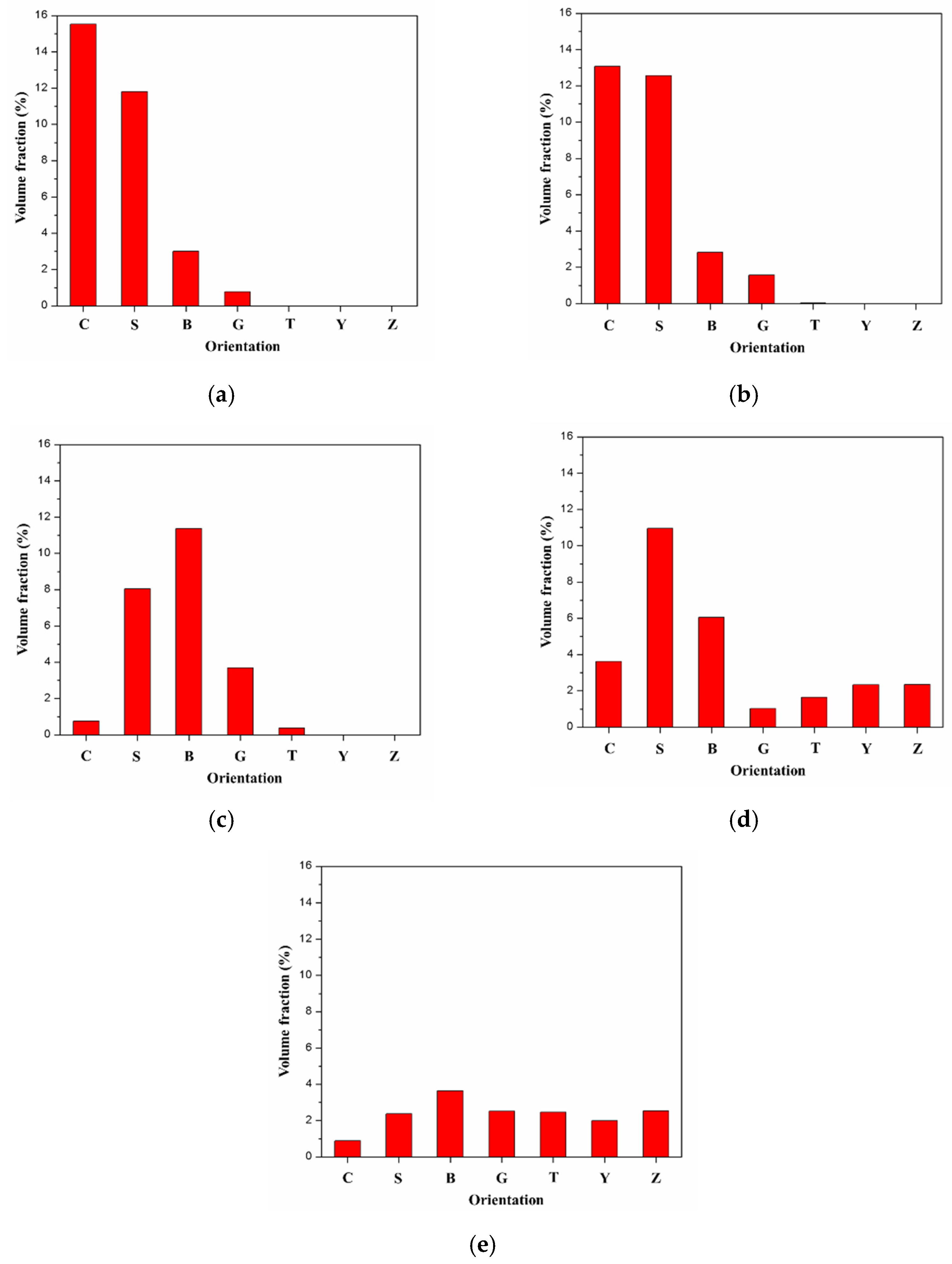
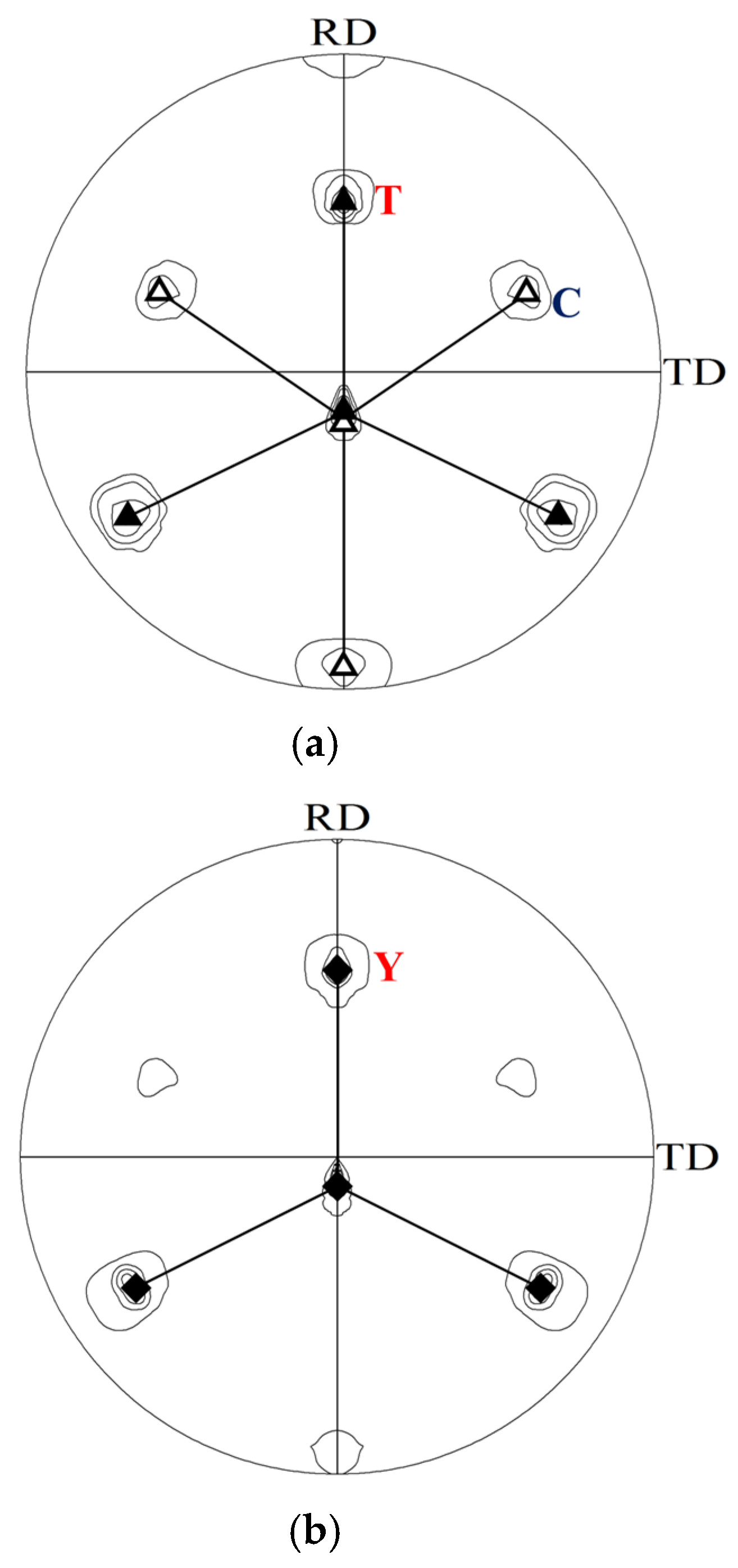
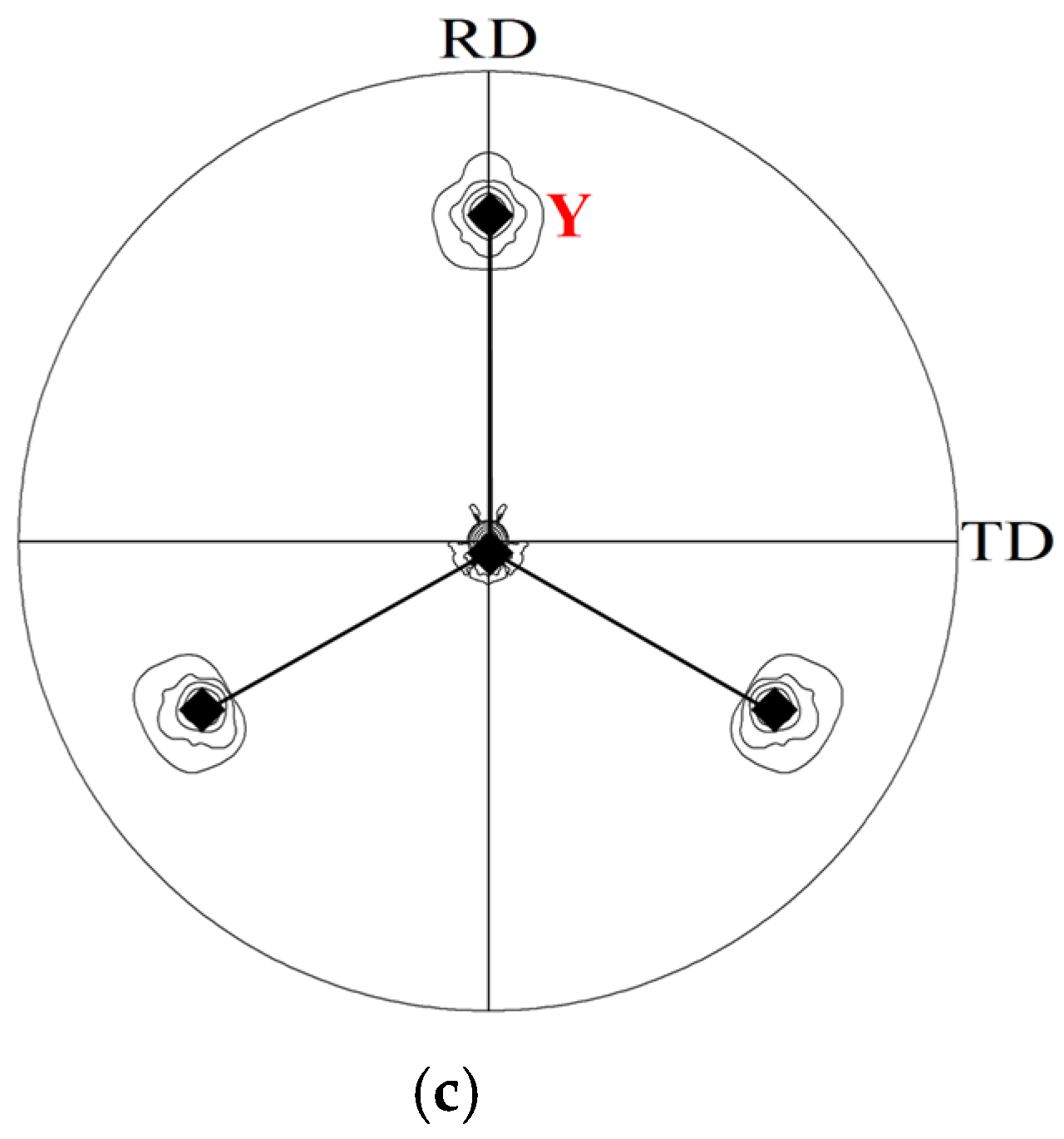






| Slip System | Slip Plane | Slip Direction | Twin System | Twin Plane | Twin Direction |
|---|---|---|---|---|---|
| SS1 | (1 1 1) | TS1 | |||
| SS2 | TS2 | ||||
| SS3 | TS3 | ||||
| SS4 | TS4 | ||||
| SS5 | TS5 | ||||
| SS6 | TS6 | ||||
| SS7 | TS7 | ||||
| SS8 | TS8 | ||||
| SS9 | TS9 | ||||
| SS10 | TS10 | ||||
| SS11 | TS11 | ||||
| SS12 | TS12 |
| Reduction | Model | Preferred Orientation | |||||
|---|---|---|---|---|---|---|---|
| C | S | B | T | Y | Z | ||
| 90% | FC | (90.0, 24.9, 45.0) | (64.9, 30.0, 65.0) | (34.6, 45.2, 0.0) | - | - | - |
| RC | (90.0, 35.1, 45.0) | (54.9, 35.1, 65.0) | (19.8, 45.1, 90.0) | - | - | - | |
| MT | - | (50.1, 40.0, 65.0) | (24.8, 45.0, 90.0) | - | - | - | |
| MTCS | (90.0, 35.2, 45.0) | (50.8, 40.0, 65.0) | (25.2, 45.1, 90.0) | (85.1, 80.1, 45.0) | (75.4, 60.2, 45.0) | (49.8, 55.1, 45.0) | |
Publisher’s Note: MDPI stays neutral with regard to jurisdictional claims in published maps and institutional affiliations. |
© 2021 by the authors. Licensee MDPI, Basel, Switzerland. This article is an open access article distributed under the terms and conditions of the Creative Commons Attribution (CC BY) license (https://creativecommons.org/licenses/by/4.0/).
Share and Cite
Hsiao, S.-C.; Lin, S.-Y.; Chen, H.-J.; Hsieh, P.-Y.; Kuo, J.-C. Rolling Texture of Cu–30%Zn Alloy Using Taylor Model Based on Twinning and Coplanar Slip. Crystals 2021, 11, 1351. https://doi.org/10.3390/cryst11111351
Hsiao S-C, Lin S-Y, Chen H-J, Hsieh P-Y, Kuo J-C. Rolling Texture of Cu–30%Zn Alloy Using Taylor Model Based on Twinning and Coplanar Slip. Crystals. 2021; 11(11):1351. https://doi.org/10.3390/cryst11111351
Chicago/Turabian StyleHsiao, Shih-Chieh, Sin-Ying Lin, Huang-Jun Chen, Ping-Yin Hsieh, and Jui-Chao Kuo. 2021. "Rolling Texture of Cu–30%Zn Alloy Using Taylor Model Based on Twinning and Coplanar Slip" Crystals 11, no. 11: 1351. https://doi.org/10.3390/cryst11111351





